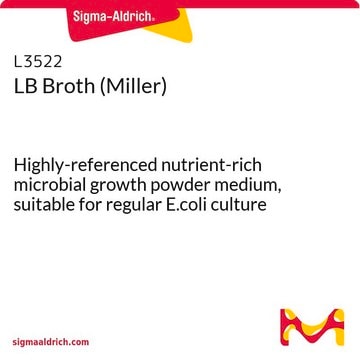L7533
LB Broth with agar (Lennox)
EZMix powder microbial growth medium
Synonym(s):
LB broth
About This Item
Recommended Products
grade
for molecular biology
Quality Level
sterility
non-sterile
form
powder
composition
Agar, 15 g/L
NaCl, 5 g/L
Tryptone, 10 g/L
Yeast Extract, 5 g/L
technique(s)
microbiological culture: suitable
application(s)
agriculture
food and beverages
microbiology
storage temp.
room temp
suitability
nonselective for Escherichia coli
nonselective for coliforms
Related Categories
General description
Application
Features and Benefits
- A budget-friendly alternative to pre-poured plates
- Granulated, dust-free format for safer handling and faster mixing
- Convenient small package to eliminate weighing
- Easy scale-up using larger package sizes
- Standard formulation
Preparation Note
2. Heat to boiling while stirring to dissolve all ingredients completely.
3. Autoclave for 15 minutes at 121°C.
To prepare Lennox L Agar: Add 1 g glucose and proceed with preparation instructions as above.
To prepare the medium of Enquist and Sternberg: Aseptically add 10 ml of sterile 1 M magnesium sulfate after autoclaving.
Reconstitution
Legal Information
related product
Storage Class Code
11 - Combustible Solids
WGK
WGK 2
Flash Point(F)
Not applicable
Flash Point(C)
Not applicable
Certificates of Analysis (COA)
Search for Certificates of Analysis (COA) by entering the products Lot/Batch Number. Lot and Batch Numbers can be found on a product’s label following the words ‘Lot’ or ‘Batch’.
Already Own This Product?
Find documentation for the products that you have recently purchased in the Document Library.
Customers Also Viewed
Articles
General protocols for growth of competent cells and their transformation (uptake of DNA).
General protocols for growth of competent cells and their transformation (uptake of DNA).
General protocols for growth of competent cells and their transformation (uptake of DNA).
General protocols for growth of competent cells and their transformation (uptake of DNA).
Protocols
Technical Article on competent cells. Transformation is a process by which some bacteria take up foreign genetic material (naked DNA) from the environment.
Technical Article on competent cells. Transformation is a process by which some bacteria take up foreign genetic material (naked DNA) from the environment.
Technical Article on competent cells. Transformation is a process by which some bacteria take up foreign genetic material (naked DNA) from the environment.
Technical Article on competent cells. Transformation is a process by which some bacteria take up foreign genetic material (naked DNA) from the environment.
Our team of scientists has experience in all areas of research including Life Science, Material Science, Chemical Synthesis, Chromatography, Analytical and many others.
Contact Technical Service













